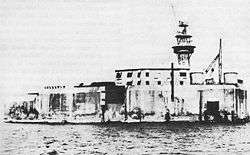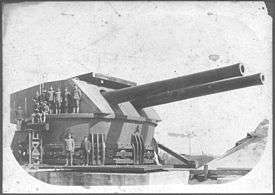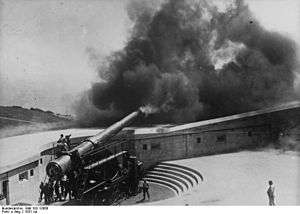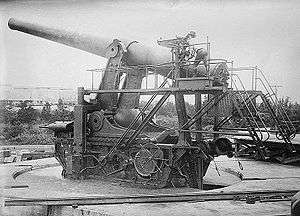14-inch gun M1907
| 14-inch Gun M1907 | |
|---|---|
|
14-inch gun on disappearing carriage, Sandy Hook Proving Ground, New Jersey | |
| Type | Coastal artillery |
| Place of origin | United States |
| Service history | |
| In service | 1908–1945 |
| Used by | United States Army |
| Wars | World War I, World War II |
| Production history | |
| Designer | Watervliet Arsenal |
| Designed | 1907–1910 |
| Manufacturer | Watervliet Arsenal |
| Variants |
M1907, M1907MI |
| Specifications | |
| Weight |
M1907: 111,900 pounds (50,800 kg) |
| Length |
M1907: 495 inches (1,260 cm) |
| Barrel length |
M1907 & M1907MI: 34 calibers (476 inches (1,210 cm)) |
|
| |
| Shell |
separate loading, bag powder charge, 1,515 pounds (687 kg) AP shot & shell [3] |
| Caliber | 14 inches (356 mm) |
| Breech | Interrupted screw, De Bange type |
| Carriage |
M1907, M1907MI, and M1910 guns: M1907 & M1907MI disappearing[4] |
| Elevation | disappearing: -5° to +15°, turret: -0.09° to +15°[6] |
| Traverse | disappearing: 170°, turret: 360° (varied with surrounding structures) |
| Maximum firing range | disappearing: 25,000 yards (23,000 m)[7] |
| Feed system | hand |
| Sights | Telescopic |
The 14-inch Gun M1907 (356 mm) and its variants the M1907MI, M1909, and M1910 were large coastal artillery pieces installed to defend major American seaports between 1895 and 1945. They were operated by the United States Army Coast Artillery Corps. Most were installed on disappearing carriages, with four guns in twin turrets at the unique Fort Drum in Manila Bay, Philippines.[8] All of the weapons not in the Philippines were scrapped during World War II.
History
In 1885, William C. Endicott, President Grover Cleveland's Secretary of War, was tasked with creating the Board of Fortifications to review seacoast defenses. The findings of the board illustrated a grim picture of existing defenses in its 1886 report and recommended a massive $127 million construction program of breech-loading guns, mortars, floating batteries, and submarine (underwater) minefields for some 29 locations on the US coastline. Most of the Board's recommendations were implemented. Coast Artillery fortifications built between 1885 and 1905 are often referred to as Endicott period fortifications.
After the Spanish–American War, the government wanted to protect American seaports in the event of war, and also protect newly gained territory, such as the Philippines and Cuba, from enemy attack. A new Board of Fortifications, under President Theodore Roosevelt's Secretary of War William Taft, was convened in 1905. Taft recommended technical changes, such as more searchlights, electrification, and in some cases less guns in particular fortifications. The seacoast forts were funded under the Spooner Act of 1902 and construction began within a few years and lasted into the 1920s. The defenses of the Philippines on islands in Manila Bay were built under this program.[9] 14-inch guns were emplaced in the harbor defenses of Los Angeles, the Panama Canal, Honolulu, Hawaii, and Manila Bay, Philippines, all constructed under the Taft program. Except for Fort Drum, the guns were on disappearing carriages; when the gun was fired, it dropped behind a concrete and/or earthen wall for protection from counter-battery fire.[8]
14-inch gun M1907 and M1907MI
The M1907 was a wire-wound gun 34 calibers long. The M1907MI was a built-up gun (the usual US practice) of the same length. Twelve were deployed, all on M1907 disappearing carriages. Four were in Hawaii and eight were in the Panama Canal Zone.[10][11]
14-inch gun M1909


The M1909 was a wire-wound gun 40 calibers long designed specifically for the turrets of Fort Drum on El Fraile Island in Manila Bay, Philippines. An unusual design feature was that it was made without trunnions.[12] The turrets were made by Newport News Shipbuilding. Fort Drum was built by razing the small island down to the water and building a massive concrete fort on it. The fort had four 14-inch M1909 guns in two twin M1909 turrets, with four 6-inch M1908 guns in casemates on the sides.[11][13] Despite holding out against Japanese bombardment, the fort was surrendered after destroying the guns along with Corregidor on 6 May 1942. It was recaptured by US Army Rangers on a modified Navy landing ship in April 1945.
14-inch gun M1910
The M1910 was a wire-wound gun 40 calibers long. Eight were deployed, all on M1907 disappearing carriages. Locations included Fort Frank and Fort Hughes in Manila Bay as well as Fort MacArthur, San Pedro, Los Angeles, CA.[14][11]
World War II
Along with other coast artillery weapons, the 14-inch guns in the Philippines saw action in the Japanese invasion in World War II. Since they were positioned against a naval attack, they were poorly sited to engage the Japanese, and the open mountings were vulnerable to air and high-angle artillery attack; their only protection was camouflage nets. Destruction procedures were executed on all the guns prior to the surrender of US forces on 6 May 1942.
In 1940–44, 16-inch gun batteries were constructed at most harbor defenses, and all 14-inch guns not in the Philippines were scrapped 1943–44.
Surviving examples

Six 14-inch guns of this type remain in the Philippines.[15]
1. Two 14-inch Guns M1909 (#4 & #3 Watervliet) in one Turret M1909 (#1 Newport News), Battery John M. Wilson, Fort Drum, El Fraile Island, Philippines.
2. Two 14-inch Guns M1909 (#2 & #1 Watervliet) in one Turret M1909 (#2 Newport News), Battery William L. Marshall, Fort Drum, El Fraile Island, Philippines.
3. One 14-inch Gun M1910 (#15 Watervliet) on Disappearing Carriage M1907MI (#20 Watervliet), Battery Gillespie, Fort Hughes, Caballo Island, Philippines.
4. One 14-inch Gun M1910 (#8 Watervliet) on Disappearing Carriage M1907MI (#17 Watervliet), Battery Woodruff, Fort Hughes, Caballo Island, Philippines.
See also
- List of U.S. Army weapons by supply catalog designation
- Seacoast defense in the United States
- Battle of Corregidor
- Coast Artillery fire control system
- 10-inch gun M1895
- 12-inch Gun M1895
- United States War department forms
References
- ↑ Description of 8, 10, 12, 14, and 16-inch Seacoast Guns, p. 45
- ↑ Description of 8, 10, 12, 14, and 16-inch Seacoast Guns, p. 45
- ↑ Berhow, p. 61
- ↑ Berhow, pp. 158–163
- ↑ Berhow, pp. 158–163
- ↑ Berhow, pp. 158–163
- ↑ Berhow, p. 61
- 1 2 Coast Defense Study Group fort and battery list
- ↑ Berhow, Mark A. and McGovern, Terrance C., American Defenses of Corregidor and Manila Bay 1898–1945, Osprey Publishing Ltd.; 1st edition, 2003; pages 7–8.
- ↑ Description of 8, 10, 12, 14, and 16-inch Seacoast Guns, p. 45
- 1 2 3 Berhow, pp. 158-163, 220-223
- ↑ Description of 8, 10, 12, 14, and 16-inch Seacoast Guns, pp. 40-42
- ↑ Berhow, pp. 102-103
- ↑ Description of 8, 10, 12, 14, and 16-inch Seacoast Guns, p. 42
- ↑ Berhow, p. 229
- Berhow, Mark A., Ed. (2004). American Seacoast Defenses, A Reference Guide, Second Edition. CDSG Press. ISBN 0-9748167-0-1.
- Lewis, Emanuel Raymond (1979). Seacoast Fortifications of the United States. Annapolis: Leeward Publications. ISBN 978-0-929521-11-4.
External links
- FortWiki
- FortWiki gun type list
- Coast Defense Study Group
- Description of Seacoast Guns 8, 10, 12, 14, 16-inch, pp. 38–45
- TM 4-210 page at the CDSG
